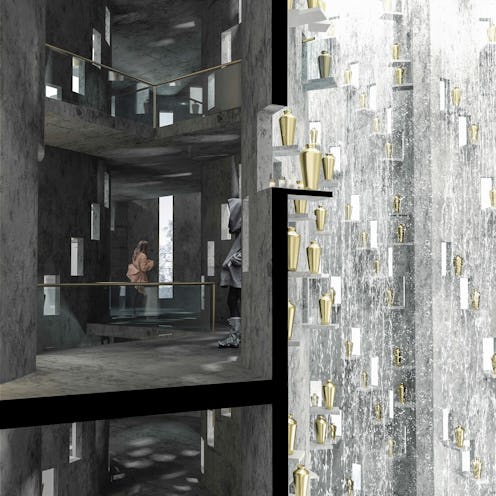Life
What A Skyscraper Cemetery Would Look Like

Architecture students Fredrik Thornström and Karolina Pajnowska have proposed a dramatic plan for the future of how we lay the dead to rest. In response to the growing shortage of available burial plots in many cities, they suggest a space conserving solution with their designs of a skyscraper cemetery. The concept, which was developed as part of their master's degree at the Lund University School of Architecture in Sweden, would repurpose an abandoned grain silo in the Nyhamnen port area of Malmö, Sweden into a columbarium and crematorium. They also propose to transform a second nearby silo into a housing development, separating the “house of the living” and “house of the dead” with a lush park the length of two city blocks.
Speaking to Dezeen Magazine on repurposing the abandoned silos into the Columbarium (a public space used for the storage of urns), Thornström and Pajnowska said, "We believe in the idea of urban recycling as one of the key factors contributing to a sustainable building culture." There is no question that many countries will be confronting a crisis as the Baby Boomer generation ages. However, there are several challenges posed by creating sustainability through the reuse of abandoned buildings while combining that use with a reinterpretation of the way we we approach funereal traditions.
In order to be appealing, a vertical cemetery must mimic the essence of a traditional cemetery— being peaceful, restful and respectful. However, traditional graveyards highlight the body's return to nature, where a building's very purpose is to separate the two. Thornström and Pajnowska balance these concerns by playing with the contrast of light and dark, as well as natural elements against stark concrete.
They describe the concept of the building as a cluster of silo-cylinders flooded with light from above. In the tall cylindrical building the urns are placed on shelves spiraling up the inner wall. Each urn is displayed on a floating shelf in front of an individual opening. It is accompanied by a candle and an evergreen plant. Water continually falls from above, and reflects light, gathering at the bottom of the silo, then travels into a pond at the entrance. The public may view the urn of their loved one through the designated window in the dark "meandering" walkway that leads up the backside of the silo. As in other famous columbrariums in Paris and London, this proposal would also include a crematorium facility, as well as an impressive ceremonial hall.
The second silo would be transformed into a housing development for the living, losing some of its stark concrete nature, gaining insulation and other features that would make it suitable as apartments. Talking to Dezeen Magazine, the designers understood the uneasiness of having the two buildings with very different purposes so close. "We don't see placing a crematorium in close vicinity of residential areas as a controversial decision — rather a justified one," they explained. They also stress that with growing populations and cities, this will soon be a reality.
In the past, designs for skyscraper cemeteries have been proposed and met with criticism. In 2013, architecture student Martin McSherry presented his idea for a tall airy structure in the center of Oslo as a solution to Norway's space shortage. There, coffins would be lifted and deposited into slots within the edifice. Over the years, the looming cemetery would grow, as Mcsheery said, "In time, the city's tallest and largest building will become a grave for all its citizens — the city's ever-changing monument." However, Israel and Brazil have already introduced modern stacked graves. Brazil currently having the tallest cemetery, reaching 32 stories in its Memorial Necropole Ecumenica.
What would a proliferation of vertical cemeteries do to a cities' landscape? Would they stand as an easily visible memorial or an unsettling reminder? And in today’s world, as we push more towards mixed-use space as a model of efficiency, it raises questions of the efficacy of a single-use space. By its very nature, the cemetery buildings would have to be single purpose, offering one type of amenity for the living — the visiting and bidding farewell to loved ones. Would the skyscraper cemetery be a plausible solution or would it only alleviate spacial constrictions temporarily? When it comes to conserving space, our cities must grow taller, but do the dead really need a final resting place with a view?
Images: Fredrik Thornström and Karolina Pajnowska